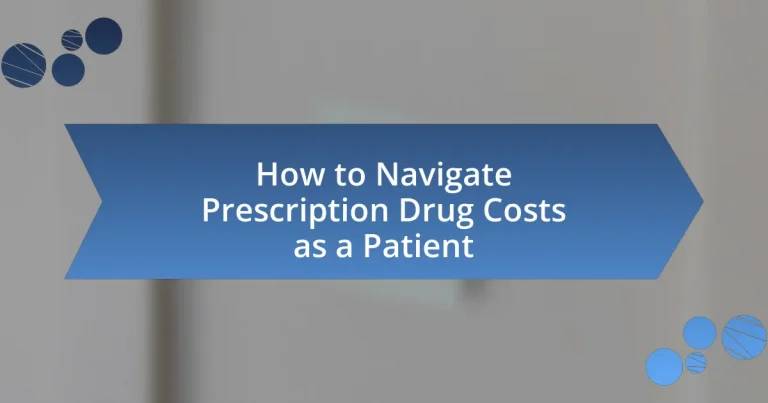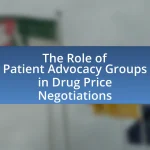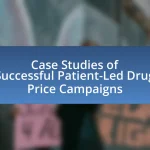The article focuses on navigating prescription drug costs as a patient, highlighting key factors that influence these costs, including research and development expenses, manufacturing costs, market competition, regulatory policies, and the role of pharmacy benefit managers. It examines how insurance plans affect pricing, the types of coverage available, and the impact of deductibles and copayments on out-of-pocket expenses. Additionally, the article discusses the influence of pharmaceutical companies on drug pricing, the significance of drug patents, and strategies patients can employ to manage costs, such as utilizing generic medications and patient assistance programs. It also outlines available resources and support systems, including government programs and non-profit organizations, to help patients facing high drug costs.
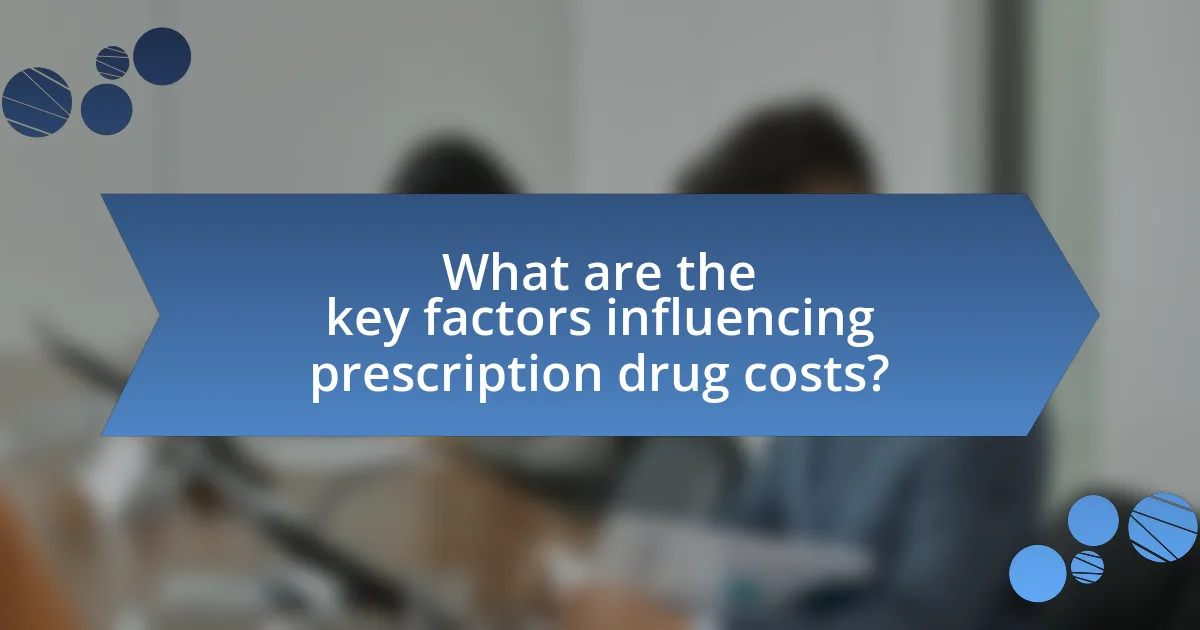
What are the key factors influencing prescription drug costs?
The key factors influencing prescription drug costs include research and development expenses, manufacturing costs, market competition, regulatory policies, and pharmacy benefit managers’ negotiations. Research and development expenses can account for billions of dollars, as developing a new drug can take over a decade and cost approximately $2.6 billion, according to a study by the Tufts Center for the Study of Drug Development. Manufacturing costs also play a role, as the complexity of production can affect pricing. Market competition influences costs, with more competitors typically leading to lower prices. Regulatory policies, including patent laws and approval processes, can extend exclusivity periods, impacting availability and pricing. Lastly, pharmacy benefit managers negotiate prices with manufacturers and pharmacies, which can significantly affect the final cost to consumers.
How do insurance plans affect prescription drug pricing?
Insurance plans significantly influence prescription drug pricing by determining which medications are covered, the level of coverage, and the out-of-pocket costs for patients. Insurance companies negotiate prices with pharmaceutical manufacturers and set formularies that list covered drugs, often leading to lower prices for insured patients compared to those without insurance. For example, a study by the Kaiser Family Foundation found that insured patients typically pay less for medications due to negotiated discounts and cost-sharing structures, such as copayments and coinsurance, which can vary widely among different plans.
What types of insurance coverage are available for prescription drugs?
There are several types of insurance coverage available for prescription drugs, including private health insurance plans, Medicare Part D, Medicaid, and employer-sponsored health plans. Private health insurance plans typically offer varying levels of coverage for prescription medications, often categorized into tiers that determine co-pays and out-of-pocket costs. Medicare Part D provides prescription drug coverage for eligible seniors and individuals with disabilities, while Medicaid offers assistance to low-income individuals and families, covering a range of prescription drugs. Employer-sponsored health plans may also include prescription drug benefits, which can vary significantly based on the employer’s choices and the specific plan design.
How do deductibles and copayments impact out-of-pocket costs?
Deductibles and copayments significantly impact out-of-pocket costs by determining the amount a patient must pay before insurance coverage begins and the portion of costs they share for each prescription. A deductible is the fixed amount a patient must pay annually before their insurance starts to cover expenses; for example, if a deductible is $1,000, the patient pays that amount out-of-pocket before receiving any insurance benefits. Copayments, on the other hand, are fixed fees that patients pay for each prescription after the deductible has been met, such as a $20 copayment for a medication. Together, these factors can lead to substantial out-of-pocket expenses, especially if the deductible is high or if the copayment amounts are significant, ultimately affecting the affordability of necessary medications.
What role do pharmaceutical companies play in drug pricing?
Pharmaceutical companies set the initial prices for drugs, significantly influencing overall drug pricing in the healthcare market. These companies determine the launch prices based on factors such as research and development costs, market demand, and competitive landscape. For instance, a study published in the Journal of the American Medical Association found that new drugs are often priced based on the maximum amount that the market can bear, rather than the cost of production. Additionally, pharmaceutical companies engage in negotiations with insurers and pharmacy benefit managers, which can further affect the final price that patients pay.
How do drug patents and exclusivity affect prices?
Drug patents and exclusivity significantly increase prices by granting pharmaceutical companies a temporary monopoly on the sale of a drug. This exclusivity allows companies to set higher prices without competition, as they are the sole providers of the patented medication. For instance, a study published in the Journal of Health Economics found that brand-name drugs can be priced up to 10 times higher than their generic counterparts due to patent protections. Consequently, patients often face higher out-of-pocket costs for medications that are under patent protection, limiting access to essential treatments.
What is the impact of research and development costs on pricing?
Research and development (R&D) costs significantly influence the pricing of prescription drugs. Pharmaceutical companies invest heavily in R&D to discover and develop new medications, with costs often exceeding billions of dollars for a single drug. For instance, a 2020 study by the Tufts Center for the Study of Drug Development reported that the average cost to develop a new prescription drug is approximately $2.6 billion, which includes expenses for failed trials and regulatory processes. These substantial R&D expenditures are typically recouped through higher drug prices, as companies seek to ensure profitability and fund future innovations. Consequently, the pricing of prescription drugs reflects not only the production costs but also the financial burden of extensive R&D efforts.
How do pharmacy benefit managers (PBMs) influence costs?
Pharmacy benefit managers (PBMs) influence costs by negotiating drug prices and managing formularies for health plans. They act as intermediaries between insurers, pharmacies, and drug manufacturers, leveraging their purchasing power to secure discounts and rebates on medications. For instance, in 2020, PBMs were responsible for managing over 80% of all prescription drug claims in the United States, which underscores their significant role in determining the prices patients pay at the pharmacy counter. Additionally, PBMs often implement cost-sharing strategies, such as tiered formularies, which can affect patient out-of-pocket expenses based on the drugs’ placement on the formulary.
What are the functions of PBMs in the prescription drug supply chain?
Pharmacy Benefit Managers (PBMs) serve several critical functions in the prescription drug supply chain, primarily focusing on managing prescription drug benefits for health plans and employers. PBMs negotiate drug prices with manufacturers, establish formularies that determine which medications are covered, and manage pharmacy networks to ensure access to medications. They also process prescription claims and implement cost-control measures, such as prior authorization and step therapy, to optimize medication use and reduce overall healthcare costs. According to the Pharmaceutical Care Management Association, PBMs save the healthcare system approximately $654 billion annually through these functions, demonstrating their significant role in controlling drug spending and improving patient access to necessary medications.
How do rebates and negotiations affect the final price for patients?
Rebates and negotiations significantly lower the final price for patients by reducing the amount that patients ultimately pay for prescription drugs. Pharmaceutical companies often provide rebates to insurers and pharmacy benefit managers, which can lead to lower out-of-pocket costs for patients when these savings are passed down. For instance, a study published in the Journal of the American Medical Association found that negotiated prices for certain medications can be up to 30% lower than the list price, directly impacting what patients pay at the pharmacy counter. Additionally, negotiations between healthcare providers and drug manufacturers can further decrease costs, ensuring that patients benefit from more affordable medication options.
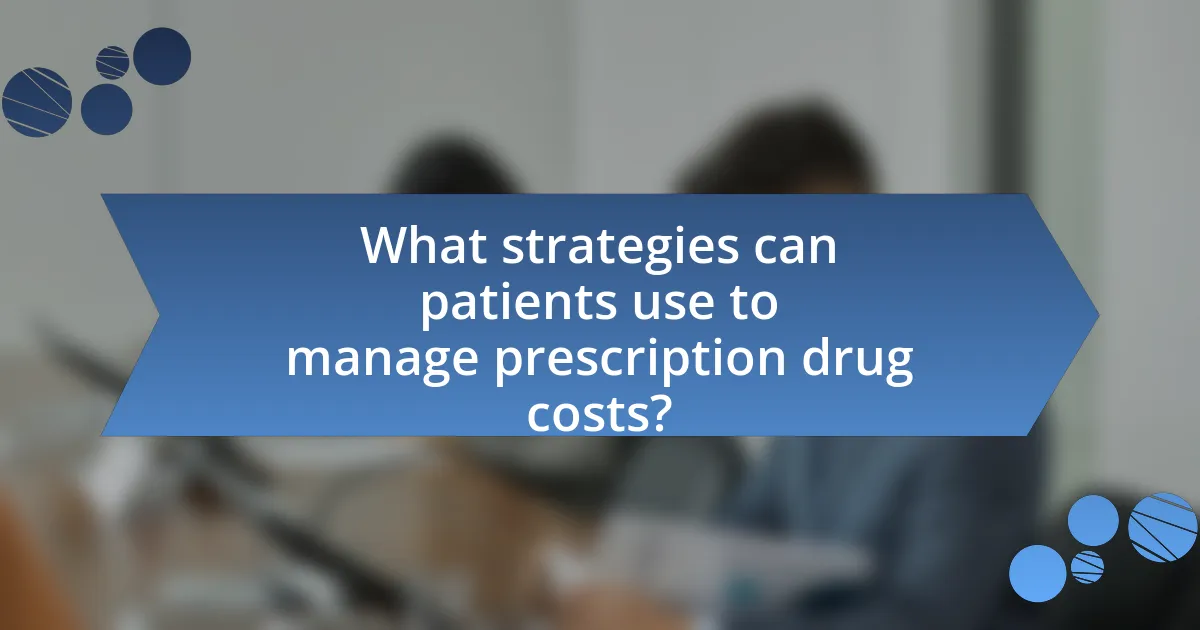
What strategies can patients use to manage prescription drug costs?
Patients can manage prescription drug costs by utilizing strategies such as comparing prices at different pharmacies, using generic medications, and leveraging patient assistance programs. Research indicates that price variations for the same medication can be significant; for instance, a study by the Journal of Managed Care & Specialty Pharmacy found that prices for common medications can differ by over 200% across pharmacies. Additionally, opting for generic versions can save patients up to 80% compared to brand-name drugs. Furthermore, many pharmaceutical companies offer patient assistance programs that provide medications at reduced costs or for free to eligible individuals, which can significantly alleviate financial burdens.
How can patients find the best prices for their medications?
Patients can find the best prices for their medications by utilizing online price comparison tools and pharmacy discount programs. Websites like GoodRx and Blink Health allow patients to compare prices across different pharmacies, often revealing significant savings. Additionally, many pharmacies offer loyalty programs or discounts for cash payments, which can further reduce costs. According to a 2021 study published in the Journal of Managed Care & Specialty Pharmacy, patients who used price comparison tools saved an average of 40% on their prescriptions.
What resources are available for comparing drug prices?
Resources available for comparing drug prices include websites and apps such as GoodRx, RxSaver, and Blink Health. These platforms allow users to search for medications and compare prices across various pharmacies, providing information on discounts and coupons. GoodRx, for instance, reports that it can save consumers up to 80% on prescription medications by showing the lowest prices available in their area. Additionally, the Centers for Medicare & Medicaid Services offers a tool called the Medicare Plan Finder, which helps users compare drug prices as part of their health insurance plans.
How can patients utilize discount programs and coupons effectively?
Patients can utilize discount programs and coupons effectively by researching available options and applying them at the point of sale. Many pharmaceutical companies and third-party organizations offer discount programs that can significantly reduce out-of-pocket costs for medications. For instance, GoodRx provides a platform where patients can compare prices and find coupons for various prescriptions, often resulting in savings of up to 80%. Additionally, patients should check with their healthcare providers or pharmacists about any available manufacturer coupons or patient assistance programs that may apply to their specific medications. By actively seeking out and applying these discounts, patients can manage their prescription drug costs more effectively.
What are the benefits of discussing costs with healthcare providers?
Discussing costs with healthcare providers leads to improved financial transparency and better management of healthcare expenses. By openly communicating about costs, patients can gain a clearer understanding of their financial responsibilities, which can help them make informed decisions regarding their treatment options. Research indicates that patients who engage in cost discussions are more likely to adhere to prescribed treatments, as they can budget effectively and avoid unexpected expenses. Furthermore, healthcare providers can offer alternative treatment options or payment plans that align with the patient’s financial situation, ultimately enhancing patient satisfaction and adherence to care.
How can patients advocate for more affordable options during consultations?
Patients can advocate for more affordable options during consultations by openly discussing their financial concerns with healthcare providers. By clearly communicating their budget constraints and asking about lower-cost alternatives, patients can encourage providers to consider generic medications or different treatment plans that fit within their financial means. Research indicates that patients who engage in these discussions are more likely to receive cost-effective solutions, as healthcare providers often have access to various pricing options and resources that can help reduce expenses.
What questions should patients ask their doctors about prescriptions?
Patients should ask their doctors about the purpose of the prescribed medication, potential side effects, and alternatives available. Understanding the purpose helps patients grasp why the medication is necessary for their condition. Inquiring about side effects allows patients to weigh the risks against the benefits, ensuring informed consent. Asking about alternatives can lead to more cost-effective or safer options, which is crucial for managing prescription drug costs. Additionally, patients should inquire about the duration of the treatment and whether the medication is covered by their insurance, as this directly impacts affordability and adherence to the prescribed regimen.
How can patients explore alternative medication options?
Patients can explore alternative medication options by consulting healthcare professionals, researching online databases, and utilizing patient advocacy resources. Healthcare professionals, such as doctors and pharmacists, can provide insights into alternative treatments that may be effective and cost-efficient. Online databases, like the National Center for Complementary and Integrative Health, offer evidence-based information on various alternative therapies. Additionally, patient advocacy organizations often provide resources and support for individuals seeking alternatives, including forums for sharing experiences and recommendations. This multifaceted approach ensures that patients make informed decisions regarding their medication options.
What are generic drugs, and how do they compare to brand-name medications?
Generic drugs are medications that have the same active ingredients, dosage form, strength, and route of administration as their brand-name counterparts but are marketed under their chemical name rather than a trademark. They are required by the FDA to meet the same quality, safety, and efficacy standards as brand-name drugs, which allows them to be considered therapeutically equivalent.
In terms of cost, generic drugs are typically much less expensive than brand-name medications, often due to the absence of the original development costs and marketing expenses associated with brand-name drugs. For example, the FDA reports that generic drugs can save consumers and the healthcare system billions of dollars annually, with prices often reduced by 30% to 80% compared to brand-name versions. This significant price difference makes generics a more accessible option for patients navigating prescription drug costs.
How can lifestyle changes reduce the need for certain prescriptions?
Lifestyle changes can significantly reduce the need for certain prescriptions by improving overall health and managing chronic conditions. For instance, adopting a balanced diet, engaging in regular physical activity, and maintaining a healthy weight can lower the risk of diseases such as diabetes and hypertension, which often require medication. Research indicates that lifestyle modifications can lead to a 58% reduction in the incidence of type 2 diabetes among high-risk individuals through weight loss and increased physical activity, as demonstrated in the Diabetes Prevention Program study. Additionally, quitting smoking and reducing alcohol consumption can decrease the need for medications related to respiratory and cardiovascular issues. These changes not only enhance health outcomes but also contribute to lower healthcare costs by minimizing reliance on prescription drugs.
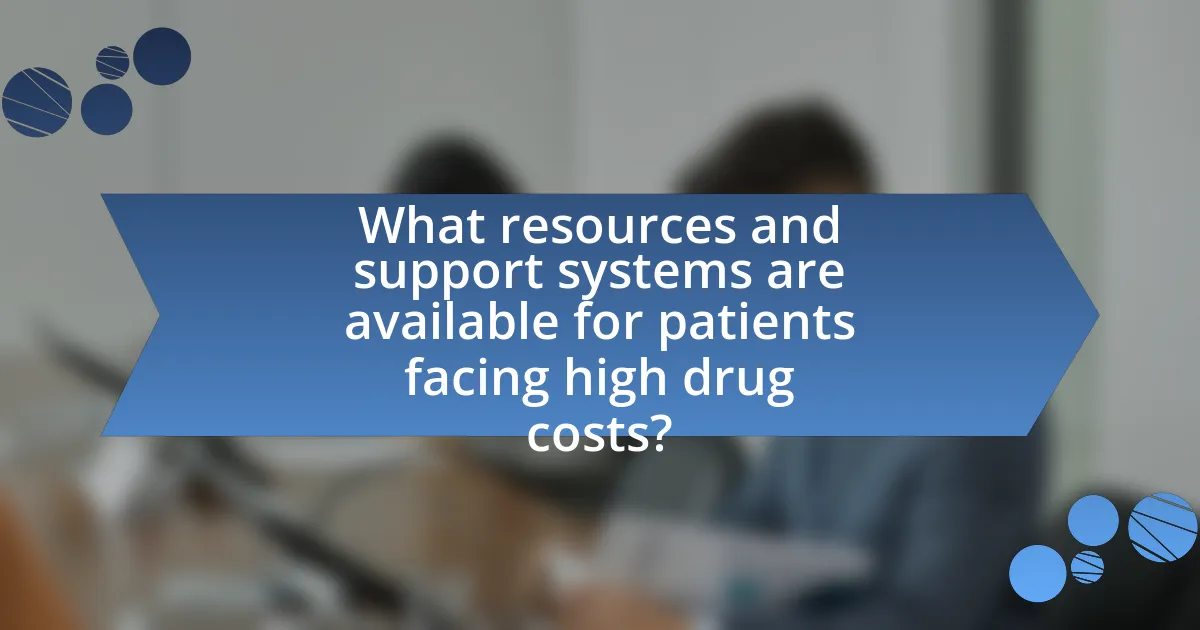
What resources and support systems are available for patients facing high drug costs?
Patients facing high drug costs can access various resources and support systems, including patient assistance programs, non-profit organizations, and government initiatives. Pharmaceutical companies often offer patient assistance programs that provide medications at reduced costs or for free to eligible individuals. Non-profit organizations, such as the Patient Advocate Foundation and NeedyMeds, provide information on financial assistance and help patients navigate their options. Additionally, government programs like Medicaid and Medicare offer coverage for prescription drugs, which can significantly lower out-of-pocket expenses. According to the Kaiser Family Foundation, nearly 1 in 4 Americans report difficulty affording their medications, highlighting the importance of these support systems in alleviating financial burdens.
What government programs assist with prescription drug costs?
The government programs that assist with prescription drug costs include Medicare Part D, Medicaid, and the Veterans Affairs (VA) prescription drug program. Medicare Part D provides prescription drug coverage to eligible seniors and individuals with disabilities, helping to lower out-of-pocket costs for medications. Medicaid offers assistance to low-income individuals and families, covering a range of prescription drugs based on state-specific guidelines. The VA program provides prescription medications at reduced costs for eligible veterans, ensuring access to necessary treatments. These programs collectively aim to alleviate the financial burden of prescription drugs for various populations.
How do Medicare and Medicaid support patients with medication expenses?
Medicare and Medicaid support patients with medication expenses through various coverage options. Medicare provides prescription drug coverage under Part D, which helps beneficiaries pay for a range of medications, often with a monthly premium and cost-sharing requirements. Medicaid, on the other hand, offers more comprehensive coverage for low-income individuals, covering most prescription drugs with minimal out-of-pocket costs. According to the Centers for Medicare & Medicaid Services, over 60 million people benefit from these programs, significantly reducing their medication expenses and improving access to necessary treatments.
What are state-specific programs that help with drug costs?
State-specific programs that help with drug costs include Medicaid, which provides assistance to low-income individuals and families in many states, and state pharmaceutical assistance programs (SPAPs) that offer financial aid for prescription medications. For example, New York has the EPIC program, which helps seniors with their drug costs, while California offers the California Prescription Drug Program to assist residents in managing their medication expenses. These programs are designed to reduce out-of-pocket costs for eligible individuals, ensuring access to necessary medications.
How can non-profit organizations provide assistance?
Non-profit organizations can provide assistance by offering financial aid, educational resources, and advocacy services to patients struggling with prescription drug costs. For instance, organizations like the Patient Advocate Foundation help patients access medications through co-pay relief programs and financial assistance for uninsured individuals. Additionally, non-profits often provide information on patient assistance programs offered by pharmaceutical companies, which can significantly reduce out-of-pocket expenses. According to the National Council of Nonprofits, these organizations play a crucial role in bridging gaps in healthcare access, ensuring that patients receive necessary medications despite financial barriers.
What types of financial aid programs are offered by charities?
Charities offer various types of financial aid programs, including direct financial assistance, medication assistance programs, and co-pay relief programs. Direct financial assistance helps patients cover immediate costs related to their healthcare, while medication assistance programs provide free or low-cost medications to those in need. Co-pay relief programs specifically assist patients with out-of-pocket costs for prescription drugs, ensuring that financial barriers do not prevent access to necessary medications. These programs are often funded by charitable organizations and aim to alleviate the financial burden on patients facing high prescription drug costs.
How can patients access patient assistance programs from pharmaceutical companies?
Patients can access patient assistance programs from pharmaceutical companies by visiting the specific company’s website or contacting their customer service. Many pharmaceutical companies offer dedicated sections on their websites that provide information about available assistance programs, eligibility criteria, and application processes. For example, programs like the Partnership for Prescription Assistance compile resources from various companies, allowing patients to find assistance based on their medication needs. Additionally, healthcare providers and pharmacists can also guide patients in navigating these programs, ensuring they receive the necessary support to afford their medications.
What practical tips can patients follow to navigate prescription drug costs effectively?
Patients can navigate prescription drug costs effectively by utilizing several practical strategies. First, patients should compare prices at different pharmacies, as costs can vary significantly; for instance, a study by the Journal of the American Medical Association found that price differences for the same medication can exceed 100%. Second, patients can ask their healthcare providers for generic alternatives, which are often less expensive and equally effective. Third, utilizing prescription discount cards or programs can lead to substantial savings; for example, GoodRx reports that users can save up to 80% on medications. Additionally, patients should consider discussing their financial situation with their healthcare provider, as they may be able to prescribe lower-cost options or provide samples. Lastly, enrolling in patient assistance programs offered by pharmaceutical companies can help those who qualify to receive medications at reduced or no cost.
How can patients stay informed about changes in drug pricing and policies?
Patients can stay informed about changes in drug pricing and policies by regularly checking official government websites, subscribing to newsletters from healthcare organizations, and utilizing patient advocacy groups. Government websites, such as the Centers for Medicare & Medicaid Services, provide updates on policy changes and pricing regulations. Healthcare organizations often send newsletters that include information on drug pricing trends and policy updates. Additionally, patient advocacy groups, like the National Patient Advocate Foundation, offer resources and alerts regarding changes that may affect patients’ access to medications. These sources ensure that patients receive accurate and timely information about the evolving landscape of drug pricing and policies.
What are the best practices for managing prescriptions and costs over time?
The best practices for managing prescriptions and costs over time include regularly reviewing medication needs, utilizing generic alternatives, and leveraging prescription discount programs. Regularly assessing medication requirements ensures that patients only pay for necessary prescriptions, which can reduce overall costs. Choosing generic medications can save patients up to 80% compared to brand-name drugs, as reported by the FDA. Additionally, utilizing prescription discount programs, such as GoodRx, can provide significant savings, with users often finding prices that are 80% lower than retail pharmacy prices. These strategies collectively help patients effectively manage their prescriptions and associated costs over time.
